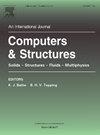基于能量的二维结构正、逆线性弹性问题求解方法
IF 4.8
2区 工程技术
Q1 COMPUTER SCIENCE, INTERDISCIPLINARY APPLICATIONS
引用次数: 0
摘要
物理信息神经网络(pinn)和深度能量法(DEM)是近年来发展起来的两种利用深度神经网络求解偏微分方程(PDEs)的方法。pinn的目标是最小化偏微分方程强形式的残余,而DEM求解器的工作原理是最小化总势能。然而,这些方法在捕捉位移和应力场的复杂特征方面存在局限性。为了克服这些局限性,本文提出了两种新的DEM扩展:基于无牵引边界损失项的深能量法(t-DEM)和基于有限元法(FEM)的能量最小化法(EMM)。t-DEM包含额外的损失项以强制执行无牵引力边界条件,EMM将FEM基础与DEM相结合,以有效地最小化系统的总势能。在本文中,我们将这些技术应用于线性弹性正解和反解问题,并比较了它们的性能。通过各种弹性标准问题验证了这些方法的有效性,并将结果与真实解进行了比较。此外,我们还进行了参数研究,以分析不同参数变化对所提出框架的影响。数值结果强调了所提出的方法对正、逆线性弹性问题的准确性和可靠性,强调了它们的潜力,特别是对应力集中问题的解决。本文章由计算机程序翻译,如有差异,请以英文原文为准。
Energy-based methods for solving forward and inverse linear elasticity problems in 2D structures
Physics Informed Neural Networks (PINNs) and the Deep Energy Method (DEM) are two recently developed approaches for solving partial differential equations (PDEs) using deep neural networks. While PINNs aim to minimize the residual of the strong form of PDEs, DEM solvers work by minimizing the total potential energy. However, these methods have limitations in capturing the complex characteristics of displacement and stress fields. To overcome these limitations, we propose two new extensions of DEM: the deep energy method with traction-free boundary loss term (t-DEM) and the energy minimization method (EMM) with finite element method (FEM) basis. The t-DEM includes an additional loss term to enforce traction-free boundary conditions, and the EMM combines the FEM basis with the DEM to efficiently minimize the total potential energy of the system.
In our paper, we apply these techniques to solve linear elasticity forward and inverse problems and compare their performance. We demonstrate the effectiveness of these methods through various elasticity standard problems and compare the results with true solutions. In addition, we conducted a parametric study to analyze the impact of different parameter variations on the proposed frameworks. The numerical results highlight the accuracy and reliability of the proposed approaches for the forward and inverse linear elasticity problems, underlining their potential, particularly for the solution of stress concentration problems.
求助全文
通过发布文献求助,成功后即可免费获取论文全文。
去求助
来源期刊

Computers & Structures
工程技术-工程:土木
CiteScore
8.80
自引率
6.40%
发文量
122
审稿时长
33 days
期刊介绍:
Computers & Structures publishes advances in the development and use of computational methods for the solution of problems in engineering and the sciences. The range of appropriate contributions is wide, and includes papers on establishing appropriate mathematical models and their numerical solution in all areas of mechanics. The journal also includes articles that present a substantial review of a field in the topics of the journal.
 求助内容:
求助内容: 应助结果提醒方式:
应助结果提醒方式:


